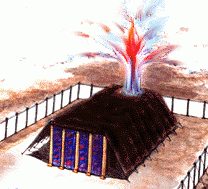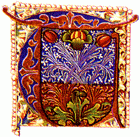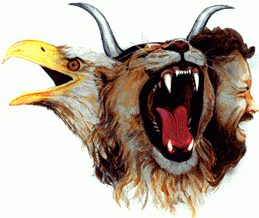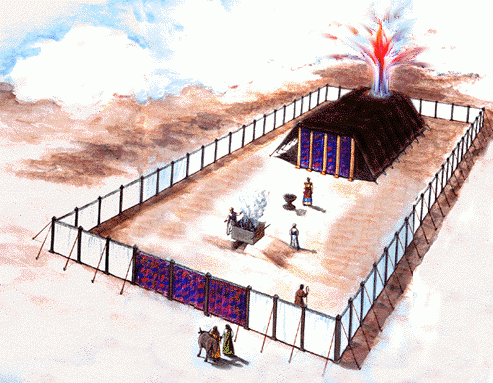1599 Geneva Bible (GNV)
The Geneva Bible: A Cornerstone of English Protestantism A Testament to Reform The 1599 Geneva Bible... Read More
The badger skin covering was a dull and unattractive skin.
It was the only covering which was visible on the outside.
The Curtain Coverings (Ex 26:1-14)


The Tabernacle itself had four coverings, the first was linen, the second was goats hair, the third was ram's skin dyed red, and the fourth was badger skins. The badger skin covering was the only covering which was seen on the outside which was that dull and unattractive skin.
Exod 26:1-14 "Moreover you shall make the tabernacle with ten curtains of fine woven linen and blue, purple, and scarlet thread; with artistic designs of cherubim you shall weave them. The length of each curtain shall be twenty-eight cubits, and the width of each curtain four cubits. And every one of the curtains shall have the same measurements. Five curtains shall be coupled to one another, and the other five curtains shall be coupled to one another. And you shall make loops of blue yarn on the edge of the curtain on the selvedge of one set, and likewise you shall do on the outer edge of the other curtain of the second set. Fifty loops you shall make in the one curtain, and fifty loops you shall make on the edge of the curtain that is on the end of the second set, that the loops may be clasped to one another. And you shall make fifty clasps of gold, and couple the curtains together with the clasps, so that it may be one tabernacle. You shall also make curtains of goats' hair, to be a tent over the tabernacle. You shall make eleven curtains. The length of each curtain shall be thirty cubits, and the width of each curtain four cubits; and the eleven curtains shall all have the same measurements. And you shall couple five curtains by themselves and six curtains by themselves, and you shall double over the sixth curtain at the forefront of the tent. You shall make fifty loops on the edge of the curtain that is outermost in one set, and fifty loops on the edge of the curtain of the second set. And you shall make fifty bronze clasps, put the clasps into the loops, and couple the tent together, that it may be one. The remnant that remains of the curtains of the tent, the half curtain that remains, shall hang over the back of the tabernacle. And a cubit on one side and a cubit on the other side, of what remains of the length of the curtains of the tent, shall hang over the sides of the tabernacle, on this side and on that side, to cover it. You shall also make a covering of ram skins dyed red for the tent, and a covering of badger skins above that."
The Tabernacle itself had four coverings, the first was linen, the second was goats hair, the third was ram's skin dyed red, and the fourth was badger skins. The badger skin covering was the only covering which was seen on the outside which was that dull and unattractive skin.
The First Covering (A Curtain)
The first covering consisted of fine twined linen (finely twisted) woven together with blue, purple and scarlet material. The colors were dyed linen. The word for 'finely twisted' linen as given in the text is an Egyptian one. Egypt was famous at the time for their production of linen and especially 'twined linen' in which every thread was twisted from many strands.
Also this extravagant curtain was decorated with figures of cherubim which were skillfully embroidered on it. Cherubim were only found on this curtain and the veil. Therefore whether it be the holy place or the holy of holies the Cherubim were seen through the framework on the innermost curtain and on the veil.

(See The Cherubim)
Cherubim (which is the plural of cherub) were celestial angelic beings in the spiritual realm. They are always associated with the holiness of God. When Adam sinned cherubim were stationed at the entrance to the Garden of Eden to guard the way to the Tree of Life.
- They represent the righteous government of God, and are the executers of God's righteous judgment.
As the priests ministered in the Holy Place they saw above them and around them at all times - the four faced Cherubim who were visual reminders of the holiness of God. The Lord continually reminded them:
Lev 11:44-45 'For I am the LORD your God. You shall therefore consecrate ourselves, and you shall be holy; for I am holy...For I am the LORD who brings you up out of the land of Egypt, to be your God. You shall therefore be holy, for I am holy.
This first beautiful covering with its cherubim put over the framework really formed the tabernacle and made it one:
Exod 26:6 "And you shall make fifty clasps of gold, and couple the curtains together with the clasps, so that it may be one tabernacle."
There were 10 of these curtains coupled together. Each of them was 28 cubits long (42 feet) by 4 cubits wide so one single length being hung over the roof and down the sides of the framework would hang 1 cubit (18 inches) short of the ground on either side. In fact they were not hung individually but five of them were joined together to make two large units, each 28 by 20 cubits.
In order to couple these two curtains together fifty loops of blue thread were sewn on the side of one curtain and the same on the other curtain. Fifty clasps of gold were then used to join the curtains to one another in order, as the instructions went, 'that it may be one tabernacle'
Exod 26:1-6 "Moreover you shall make the tabernacle with ten curtains of fine woven linen and blue, purple, and scarlet thread; with artistic designs of cherubim you shall weave them. The length of each curtain shall be twenty-eight cubits, and the width of each curtain four cubits. And every one of the curtains shall have the same measurements. Five curtains shall be coupled to one another, and the other five curtains shall be coupled to one another. And you shall make loops of blue yarn on the edge of the curtain on the selvedge of one set, and likewise you shall do on the outer edge of the other curtain of the second set. Fifty loops you shall make in the one curtain, and fifty loops you shall make on the edge of the curtain that is on the end of the second set, that the loops may be clasped to one another. And you shall make fifty clasps of gold, and couple the curtains together with the clasps, so that it may be one tabernacle."
It is interesting that this bringing together and making one, is just like the words that Jesus used when He prayed for the lives of his followers:
John 17:20-22 "I do not pray for these alone, but also for those who will believe in Me through their word; that they all may be one, as You, Father, are in Me, and I in You; that they also may be one in Us, that the world may believe that You sent Me. And the glory which You gave Me I have given them, that they may be one just as We are one"
Just as there must be no possibility of the separation or drawing apart of the curtains covering the holy place, so the body of Christ (His Church) should be one and not divided.
The Second Covering (Goats Hair)
Over this first tent covering there was a second tent placed which was slightly larger in size. It was made from black goat's hair woven together. Instead of starting with ten narrow curtains, this time eleven were used, each of them was 30 cubits by 4 cubits. This meant, that because it was 2 cubits longer than the linen curtain, it reached right down to ground level and entirely covered the first one.
Six of these curtains were joined to make a large curtain and the remaining five to form another. The two large curtains were then united in a similar way to the first but since this curtain was less precious than that which enfolded the Holy area, the clasps holding the 50 loops were made of bronze and not of gold.
The principle was the same throughout the entire tabernacle. The further you moved from the holy of holies the less valuable were the materials used. And the lesson for us is that in the presence of God there is beauty and purity (gold) and as you move away back out into the world there is only judgment (bronze) and a need of continual cleansing.
The entire length of the completed curtain, 44 cubits (66 feet) by 30 cubits (45 feet) was used for making a fold in front above the entrance and also for overlapping the under-curtain around the sides and at the back of the tent.
Exod 26:9 "And you shall couple five curtains by themselves and six curtains by themselves, and you shall double over the sixth curtain at the forefront of the tent."
It also meant that the two curtains (this one and the one beneath) could be draped in such a way that their attachments did not coincide.
The Third Covering (Ram Skins Dyed Red)
The third covering was of ram skins dyed red. It was the first of the two weatherproof coverings
Exod 26:14 "You shall also make a covering of ram skins dyed red for the tent, and a covering of badger skins above that."
Rams were used for sacrifice, as in the account with Abraham and Isaac, and the red always represents blood for the atonement.
(See Blood Atonement)
It is interesting that there were no measurements given for this covering.
(4) The Fourth Covering (Badger Skins)
The fourth covering was made of badgers' skins and again no measurements were given.
The Hebrew word for badger skins 'tachash' may refer to a badger or a Dugong or Sea Cow. A Dugong is an aquatic mammal previously found swimming along the shores of the Red Sea, it is now almost extinct.
Once again in the tabernacle covering there was a progression from the more beautiful to the less attractive. From the first covering of the finest white linen woven with blue, purple and scarlet and decorated with cherubim to the unattractive badger skin covering on the outside.
But the final cover of badger skins was far from beautiful. You can't help but imagine what a foreigner passing by must have thought to see this unattractive tent as the focal point for the worship of Yahweh. But as with everything in the kingdom of God, the harder we search and the deeper we look for the things of god, the more beauty and splendor we find.

A Type of Christ
Each of the tabernacle coverings pointed to Jesus Christ. The innermost curtain with its four colors and the cherubim woven into the fine white linen, the second covering of goats hair spoke of Jesus Christ and His sacrifice, remember the scapegoat that carried away the sins of the nation in the wilderness, and the third covering of rams skins dyed red also pointed to Jesus as our substitute just as the ram was the substitute for Isaac when his father Abraham was lifting the knife. But the last covering was of the badger skins. It also pointed to Jesus Christ. As the badger skins had that unattractive outward appearance so Jesus was a normal Israelite man with nothing especially attractive about Him that would make us think he was the King of kings. He was humble in character. No one has any idea what Jesus looked like whatsoever except that He had a beard because Isaiah spoke of His beard being plucked. He was a Jew and He had a beard and that is all that can be derived from the Bible and history. But His appearance was just as any common Israelite.
In the tabernacle there was a clear resemblance to Jesus Christ. The person who looks at Him on just the outside at his physical appearance would never grasp the beauty and the wonder that resides in Jesus.
As Isaiah prophesied:
Isa 53:2 "For He shall grow up before Him as a tender plant, and as a root out of dry ground. He has no form or comeliness; and when we see Him, there is no beauty that we should desire Him."
Isaiah spoke of Christ:
Isa 33:17 "Your eyes will see the King in His beauty..."
He was indeed a sin offering
2 Cor 5:21 For He made Him who knew no sin to be sin for us, that we might become the righteousness of God in Him.
Matt 27:46 And about the ninth hour Jesus cried out with a loud voice, saying, "Eli, Eli, lama sabachthani?" that is, "My God, My God, why have You forsaken Me?"
He was our substitute
Heb 2:9 But we see Jesus, who was made a little lower than the angels, for the suffering of death crowned with glory and honor, that He, by the grace of God, might taste death for everyone.
Jn 1:29 The next day John saw Jesus coming toward him, and said, "Behold! The Lamb of God who takes away the sin of the world!
Is 53:6 All we like sheep have gone astray; we have turned, every one, to his own way; and the LORD has laid on Him the iniquity of us all.
Is 53:2-3 For He shall grow up before Him as a tender plant, and as a root out of dry ground. He has no form or comeliness; and when we see Him, there is no beauty that we should desire Him. He is despised and rejected by men, a Man of sorrows and acquainted with grief. And we hid, as it were, our faces from Him; he was despised, and we did not esteem Him.
Matt 13:13 "Therefore I speak to them in parables, because seeing they do not see, and hearing they do not hear, nor do they understand.
Matt 13:16-17 "But blessed are your eyes for they see, and your ears for they hear; "for assuredly, I say to you that many prophets and righteous men desired to see what you see, and did not see it, and to hear what you hear, and did not hear it.
His outward appearance was not adorned..

